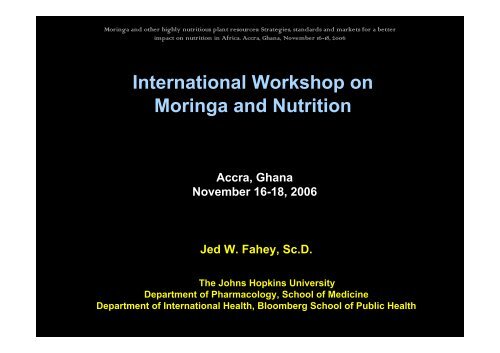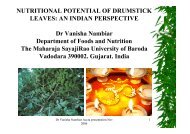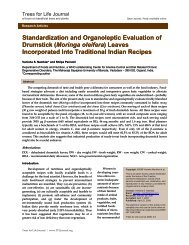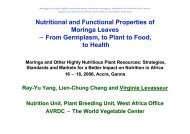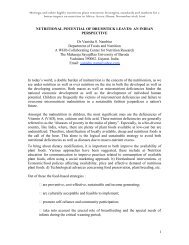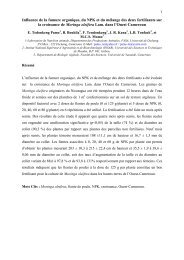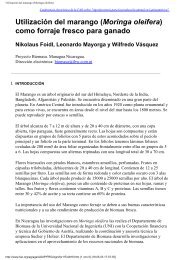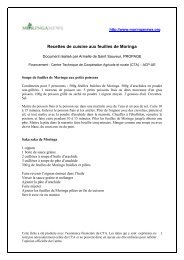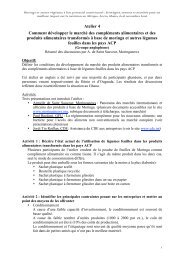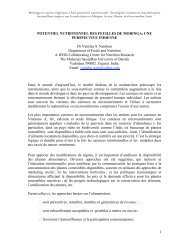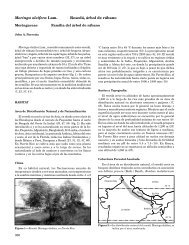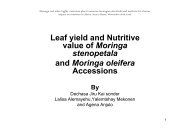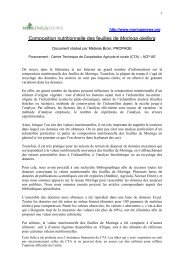International Workshop on Moringa and Nutrition - Moringanews
International Workshop on Moringa and Nutrition - Moringanews
International Workshop on Moringa and Nutrition - Moringanews
You also want an ePaper? Increase the reach of your titles
YUMPU automatically turns print PDFs into web optimized ePapers that Google loves.
<strong>Moringa</strong> <strong>and</strong> other highly nutritious plant resources: Strategies, st<strong>and</strong>ards <strong>and</strong> markets for a betterimpact <strong>on</strong> nutriti<strong>on</strong> in Africa. Accra, Ghana, November 16-18, 2006<str<strong>on</strong>g>Internati<strong>on</strong>al</str<strong>on</strong>g> <str<strong>on</strong>g>Workshop</str<strong>on</strong>g> <strong>on</strong><strong>Moringa</strong> <strong>and</strong> Nutriti<strong>on</strong>Accra, GhanaNovember 16-18, 2006Jed W. Fahey, Sc.D.The Johns Hopkins UniversityDepartment of Pharmacology, School of MedicineDepartment of <str<strong>on</strong>g>Internati<strong>on</strong>al</str<strong>on</strong>g> Health, Bloomberg School of Public Health
Nutriti<strong>on</strong>al Benefits, Toxicology, <strong>and</strong> Health Effectsof <strong>Moringa</strong> Leaf Powder vis-à-vis Treatment ofMalnutriti<strong>on</strong>+Cultivar Effect <strong>on</strong> <strong>Moringa</strong> oleifera GlucosinolateC<strong>on</strong>tent, Taste, <strong>and</strong> Performance Characteristics:A Pilot StudyBeth Doerr 1 , Kristina L. Wade 2 , Katherine K. Stephens<strong>on</strong> 2 ,Stewart B. Reed 3 , William Osburn 4 , Thomas W. Kensler 4 , &Jed W. Fahey 2,51ECHO Educati<strong>on</strong>al (North Ft. Myers, FL, USA)<strong>and</strong>The Johns Hopkins University (Baltimore, Maryl<strong>and</strong>, USA)2School of Medicine, Department of Pharmacology3Post-Baccalaureate Premedical Program4School of Public Health, Department of Envir<strong>on</strong>mental Health Sciences5School of Public Health, Department of <str<strong>on</strong>g>Internati<strong>on</strong>al</str<strong>on</strong>g> Health
General <strong>Moringa</strong> Reviews, by:Julia Mort<strong>on</strong>Lowell FuglieManuel PaladaMartin PriceTrees for LifeNati<strong>on</strong>al Academy of Sciences U.S.A. (just published)
OverviewNutriti<strong>on</strong>al Benefits, Toxicology, <strong>and</strong> Health Effects of <strong>Moringa</strong> LeafPowder vis-à-vis Treatment of Malnutriti<strong>on</strong>1. Some risks?– In mice– In tilapia (a widely aquacultured species of fish)– In human beings2. Some benefits?– Cancer protecti<strong>on</strong>– Combating Helicobacter pylori infecti<strong>on</strong>Cultivar Effect <strong>on</strong> <strong>Moringa</strong> oleifera Glucosinolate C<strong>on</strong>tent, Taste, <strong>and</strong>Performance Characteristics: A Pilot Study3. Variability– Taste– Phytochemical (glucosinolate) c<strong>on</strong>tent
Framing the discussi<strong>on</strong>:Primary Food Sourcevs.Nutriti<strong>on</strong>al Supplementati<strong>on</strong>While not mutually exclusive, these 2 strategies for using<strong>Moringa</strong> leaves address very different usage patterns <strong>and</strong>sets of needs.They both require additi<strong>on</strong>al, rigorous, scientific research.
<strong>Moringa</strong> Leaf Powder vs. Malnutriti<strong>on</strong>• As A Primary Food Source– Dietary replacement• (substituting <strong>Moringa</strong> for something else)• high rate substituti<strong>on</strong> (>10% of diet)– Famine food• when nothing else is available• Treating Acute Malnutriti<strong>on</strong> (Nutriti<strong>on</strong>al Supplementati<strong>on</strong>)– Relief of vitamin, mineral deficiencies– Treating Protein-Energy Malnutriti<strong>on</strong>– Combating stunting, wasting <strong>and</strong> failure-to-thrive in infants &children– Combating chr<strong>on</strong>ic infectious diseases
Out research interest in high rate supplementati<strong>on</strong>grew out of cancer preventi<strong>on</strong> experiments in whichwe had to administer very high rates of leaf powder toanimals, to get the desired glucosinolate levels.
Effect of high rate <strong>Moringa</strong> leaf powdersupplementati<strong>on</strong> for 38 days, <strong>on</strong> female ICRmouse organ developmentAIN7640% <strong>Moringa</strong>MeanS.E.M.MeanS.E.M.Liver Ratio (g liver/g BW)0.0580.0040.0590.003Col<strong>on</strong> (cm)8.60.4110.5Norm. col<strong>on</strong> (cm/g)0.220.010.360.02Cecum (cm)2.80.13.70.2Cecum – Normalized (cm/g)0.0720.0050.120.01Col<strong>on</strong>:cecum ratio3.10.130.1
Growth performance <strong>and</strong> nutrient utilizati<strong>on</strong> of tilapia fed 40% dry moringaleaf powder enriched diet vs c<strong>on</strong>trol diet.C<strong>on</strong>trol <strong>Moringa</strong> (40%)initial body weight (g) 16.9 ± 4.5 16.3 ± 4.5body weight gain (g) 38.1 ± 4.5 14.5 ± 4.5Data from: W Afuang, P Siddhuraju & K Becker (2003) Comparative nutriti<strong>on</strong>al evaluati<strong>on</strong> of raw, methanolextracted residues <strong>and</strong> methanol extracts of moringa (<strong>Moringa</strong> oleifera Lam.) leaves <strong>on</strong> growth performance<strong>and</strong> feed utilizati<strong>on</strong> in Nile tilapia (Oreochromis niloticus L.). Aquaculture Research 34: 1147-1159
Diet compositi<strong>on</strong> (%, dry matter basis)Data from: W Afuang, P Siddhuraju & K Becker (2003) Comparative nutriti<strong>on</strong>al evaluati<strong>on</strong> of raw, methanolextracted residues <strong>and</strong> methanol extracts of moringa (<strong>Moringa</strong> oleifera Lam.) leaves <strong>on</strong> growth performance<strong>and</strong> feed utilizati<strong>on</strong> in Nile tilapia (Oreochromis niloticus L.). Aquaculture Research 34: 1147-1159
•Sap<strong>on</strong>ins (for example)•Broad class of phytochemicals:•effects <strong>on</strong> livestock producti<strong>on</strong> well documented•effects <strong>on</strong> humans complex <strong>and</strong> c<strong>on</strong>tradictory•some useful for c<strong>on</strong>trolling cholesterol•others toxic or cause urticaria (skin rash)•<strong>Moringa</strong> sap<strong>on</strong>ins•occur at substantial levels (1-5%) in <strong>Moringa</strong> oleifera leaves.*•d<strong>on</strong>’t appear to be toxic at levels that are being c<strong>on</strong>sumed by people•might they be toxic when c<strong>on</strong>sumed as a large percentage of the diet?Makkar & Becker (1996) Animal Feed Science Technology 63: 211-228
Mekk<strong>on</strong>en et al. dem<strong>on</strong>strated cytotoxicity at a high level of extract(500 µg/ml).“. . .a highly significant . . . decrease in the percentage ofviable hepatocytes was found after incubating the cellswith the highest c<strong>on</strong>centrati<strong>on</strong> (500 µg/ml) of the ethanolleaf <strong>and</strong> seed extracts of <strong>Moringa</strong> stenopetala. . .”[Mek<strong>on</strong>nen et al., (2005) Phytotherapy Research 19: 870-875]?????Is this a problem vis-à-vis supplementary feeding of human beings?At some level, all plant extracts will have a deleterious effect <strong>on</strong>cultured cells.How does this cytotoxicity relate to pathology <strong>and</strong> to the humanc<strong>on</strong>diti<strong>on</strong>?(ug extract / ml of culture medium vs. grams of intake of food or foodproduct per day)?
Effects of plant extracts <strong>on</strong> cultured Hepa1c1c7 cells
?? Goitrogenicity ??“. . . The presence of a small amount of cyanogenic glucosidesin M. stenopetala leaves may have a health risk in areas of highincidence of endemic goitre as an exacerbating factor ifc<strong>on</strong>sumed for a l<strong>on</strong>g period of time.”79–89 mg cyanogenic glucosides / 100 gAbuye et al. (2003) East African Medical Journal 80(5): 247-252
?? Goitrogenicity ??However . . .•Indeed, progoitrin (a glucosinolate) produces goitrin(an isothiocyanate), which up<strong>on</strong> breakdown producesan oxazolid<strong>on</strong>ethi<strong>on</strong>e, that is goitrogenic.•Indole glucosinolates are thought to have goitrogenicpotential.•<strong>Moringa</strong> spp. have neither progoitrin, nor significantlevels of indole glucosinolates. They do, however,have thiocyanates which should be more intensivelyexamined for their goitrogenicity (Ref. Faizi, Sidiqui,Guevera, et al.)
CH 2nC NRCNHOSOSO 3OHOOHCH 2 OHH 2 OglucoseMYROSINASERCNSOSO 3SRC NHSO 4R N C SGLUCOSINOLATEISOTHIOCYANATEFahey et al (2001) Phytochemistry 56(1): 5-51
Hydrolysis of β-hydroxyalkenylglucosinolates (e.g. progoitrin &napoleiferin), gives rise to β-hydroxyalkenyl isothiocyanates.ProgoitrinNapoleiferinThese compounds cyclize to oxazolidine-2-thi<strong>on</strong>eswhich may have goitrogenic effects in mammals -- firstobserved in rabbits <strong>and</strong> designated ``cabbage'' goiterby Webster <strong>and</strong> Chesney (1930).The ``antinutriti<strong>on</strong>al'' nature of the β-hydroxyalkenylglucosinolates is discussed in a variety of publishedworks.1-5-v inyl-2-thiooxazolid<strong>on</strong>e
Chemoprotecti<strong>on</strong> Bey<strong>on</strong>d Broccoli:<strong>Moringa</strong> oleifera (Horseradish tree) & M. stenopetala (Cabbage tree):Edible, Nutritious <strong>and</strong> Medicinal Tropical Trees
Antibacterial potency of a variety of plantderivedisothiocyanates against Helicobacterpylorifrom broccoli sproutsfrom <strong>Moringa</strong>MIC 90(µg/ml)25 H.pylori strains3020100OSROSRORSRS ORS OORS O1 2 3 4 5 6 7 8 9 10 11 12Iberin Cheirolin Erucin Sulforahane SulforapheneErysolin Berteroin Alyssin HirsutinPhenylethyl-ITC Benzyl-ITC 4RBITCSROSRRS ORRHOHOOROOHCH 3Redrawn from: Haristoy, Fahey, Scholtus, Lozniewski (2005) Planta Medica 71: 326-330.
<str<strong>on</strong>g>Internati<strong>on</strong>al</str<strong>on</strong>g> C<strong>on</strong>sensus C<strong>on</strong>ference (Feb 05):Why an edible plant-based approach to H. pylori treatment?• Inexpensive• Underserved populati<strong>on</strong>s ± indigenous plants• May be effective where synthetic antibiotics are not• Anti-inflammatory activity of ITCs may have 2°benefit against gastritis• Prevent or ameliorate symptoms of gastritis, pepticulcer or stomach cancer vs. complete cure?
On the <strong>on</strong>e h<strong>and</strong>, the fact that many ethnic groupshave c<strong>on</strong>sumed <strong>Moringa</strong> leaves <strong>and</strong> leaf powder formany generati<strong>on</strong>s is a very positive indicati<strong>on</strong> . . .After all, tolerance, safety, <strong>and</strong> toxicology studiesare not performed <strong>on</strong> corn, wheat, squash, <strong>and</strong>groundnuts.On the other h<strong>and</strong>, performing a safety <strong>and</strong>tolerance study like the following (just completedwith broccoli sprouts) would be a reas<strong>on</strong>ableundertaking. Funding must be developed for such atrial, which would then facilitate a variety ofnutriti<strong>on</strong>al efficacy studies that global fundingagencies have seemed reluctant to back so far.
For example, <strong>on</strong>e could readily substitute <strong>Moringa</strong> leaf powder in anexperimental design like the following, which we have just published“Widely c<strong>on</strong>sumed in many parts of the world, <strong>and</strong> have not caused any c<strong>on</strong>cern withrespect to their tolerance <strong>and</strong> safety in humans. Nevertheless, a formal Phase I study ofsafety, tolerance, <strong>and</strong> pharmacokinetics appeared justified”• Placebo-c<strong>on</strong>trolled, double blind, r<strong>and</strong>omized clinical study• Healthy volunteers -- inpatients <strong>on</strong> our clinical research unit• 5-day acclimatizati<strong>on</strong> period <strong>on</strong> a crucifer-free diet• Oral intake of st<strong>and</strong>ardized broccoli sprout extract• 8-h intervals for 7 days (21 doses)• 32 types of hematology or chemistry tests (before, during, <strong>and</strong> after dosing)• Liver (transaminases) <strong>and</strong> thyroid (TSH, T3, <strong>and</strong> T4) functi<strong>on</strong> examined in detail• No significant or c<strong>on</strong>sistent subjective or objective abnormal events or toxicities
30 Accessi<strong>on</strong>s; 3 Harvest Dates; 10 Taste Testers
30 Accessi<strong>on</strong>s; 3 Harvest Dates; 10 Taste Testers<strong>Moringa</strong> leaves being promoted as nutriti<strong>on</strong>al supplement for weaninginfants <strong>and</strong> nursing mothers.Adopti<strong>on</strong> as a nutritious supplement may hinge up<strong>on</strong> taste.Taste can vary greatly am<strong>on</strong>gst cultivars, from quite mild, to excepti<strong>on</strong>allypungent, astringent, <strong>and</strong> “radishy".Widely assumed to be germplasm-dependent (i.e. the breeding line orcultivar dictates taste).Prior knowledge of <strong>on</strong>e of the major phytochemical comp<strong>on</strong>ents of<strong>Moringa</strong>, the glucosinolates, suggests that they might be a comp<strong>on</strong>ent ofthis harshness of taste.These glucosinolates, <strong>and</strong> their breakdown products (isothiocyanates), arealso implicated in many of the medicinal properties of M. oleifera.
•Regi<strong>on</strong>al preferences regarding taste <strong>and</strong> other organoleptic,horticultural, <strong>and</strong> agr<strong>on</strong>omic characteristics vary greatly.•The taste of fresh leaves is known to vary greatly -- some of themare quite “radishy”, hot, <strong>and</strong> pungent, while others are very mild.•To the extent that the leaves (typically dried <strong>and</strong> powdered) aresuggested for use in weaning porridges, it would seem to beimportant to be able to suggest or provide sources of less harsh orless radishy tasting leaves.•Although the potential aversi<strong>on</strong> of infants to a very pungent gruelhas not been tested scientifically, from a comm<strong>on</strong>sense st<strong>and</strong>pointit would seem logical that having taste opti<strong>on</strong>s would be beneficial.
Since at least two breeding lines (designated PKM1 <strong>and</strong> PKM2) havenow been developed, <strong>and</strong> the potential health benefits that <strong>Moringa</strong>offers is widely recognized, we undertook a pilot study to investigatethe associati<strong>on</strong> between pungent taste <strong>and</strong> glucosinolate levels of theleaves of this plant.283 trees, representing 30 accessi<strong>on</strong>s, were grown in a r<strong>and</strong>omized fieldplot at a single site in central Florida, USASampled three times over the course of a year.Taste was assessed by 9 or 10 individuals in a masked protocol.In additi<strong>on</strong>:- glucosinolate c<strong>on</strong>tent was measured- performance was assessed <strong>and</strong> compared:number of brancheshoriz<strong>on</strong>tal-to-vertical branchingleaf sizetree heighttree girthcanopy biomass
Accessi<strong>on</strong> designati<strong>on</strong>sSourceAccessi<strong>on</strong> Designati<strong>on</strong> No.SourceAccessi<strong>on</strong> Designati<strong>on</strong> No.North AmericaBradent<strong>on</strong>, Florida 02099-021D 11ECHO Farm 92028-991E 3Fort Myers 92026 4N. Wood, Florida 00099-001D 2Central AmericaVilloria, Belize 03051-031D 16Mexico 01084-011D 10CaribbeanK. Flanagan, Haiti 01046-011A 18Bohoc, Haiti 02055-021H 15La G<strong>on</strong>ave, Haiti 02073-021H 7Les Cayes, Haiti 02057-021H 9Port Au Prince, Haiti 02056-021H 14C. Thede, Haiti 03064-031H 22C. Thede, Haiti 03065-031H 23C. Thede, Haiti 03067-031H 26C. Thede, Haiti 03068-031H 20C. Thede, Haiti 03069-031H 21Archai, Haiti 03070-031H 24C. Thede, Haiti 03071-031H 29Titayen, Haiti 02058-021H 1South AsiaPKM-1 Horti, India 00045-011A 12PKM-2 U.Asmar, India 03005-031A 19Pocha Exports, India 91070 27Trust Hospital, India 03056-031D 28AfricaCWS Senegal 03052-031D 5Tanzania/Malawi 98018 17Msingi, Tanzania 03034-031D 8Optima, Tanzania 01088-011D 13Optima, Tanzania 03066-031H 25Groves, Mozambique 03055-031D 30Binga Trees, Zimbabwe 03053-031D 6
m!(120SGlatoT100806040200-5.00 34.67 74.33 114.001st 2nd 3rdHarvestp for trend by harvest datewas highly significant (p
tsevraH!mol Total RBGS's / gram leaf tissue120100Thede, Haiti (8a)Bradent<strong>on</strong> FLA (4a)dr380604020PKM-2 (7a)PKM-1 (4c)010080Thede, Haiti (7c)Pocha Exports, India (9c)1 60s 40tH 20arvest0406080100120 2nd Harvest200
•These findings suggest that deliberate selecti<strong>on</strong> for agr<strong>on</strong>omic,taste, or quality factors can be made without jeopardizing thec<strong>on</strong>tent of <strong>on</strong>e of the more important phytochemicals in <strong>Moringa</strong>.•However, this field trial has not been replicated across multiplesoil types, climates, or geographic envir<strong>on</strong>ments.•If intelligent efforts are to be directed towards producing <strong>and</strong>disseminating plants with a specific taste (e.g. mild) for specificpurposes (e.g. weaning food), baseline informati<strong>on</strong> <strong>on</strong> thesequalities must first be developed.•Ultimately, it will be necessary to determine the degree to whichharshness of taste is c<strong>on</strong>trolled by the genetics of a cultivar,variety, or accessi<strong>on</strong>, <strong>and</strong> by the envir<strong>on</strong>mental c<strong>on</strong>diti<strong>on</strong>s inwhich the plants are grown (soil type, water status, amount ofheat, drought, <strong>and</strong> pathogen stress, etc.).•Leaf or foliage producti<strong>on</strong> (e.g. biomass) must also be bettercharacterized.
www.tfljournal.orgjfahey@jhmi.edu


